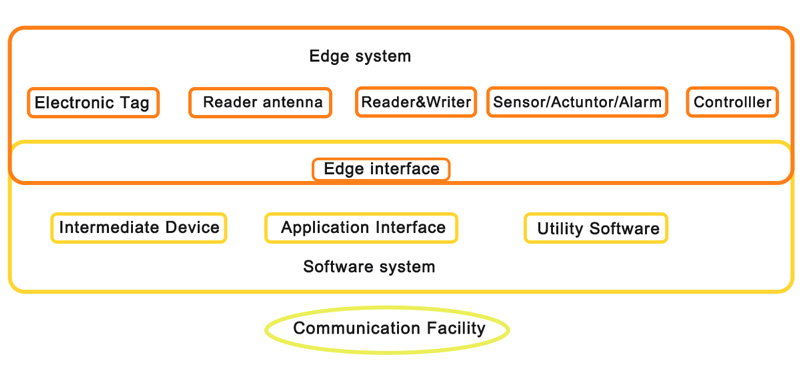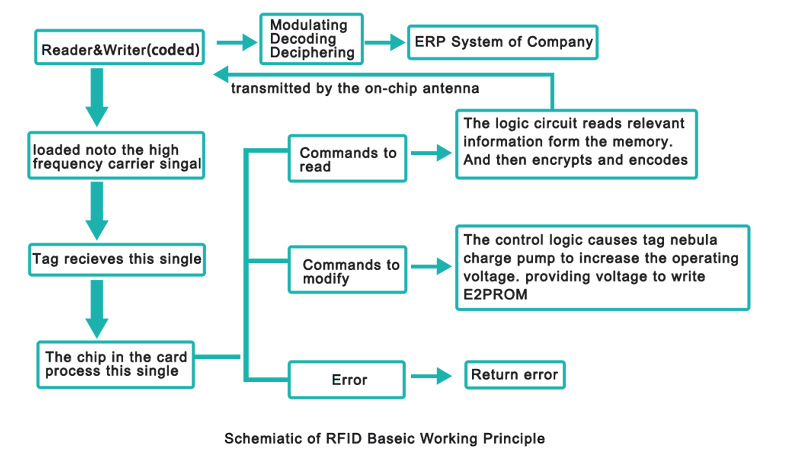Radio Frequency Identification (RFID) technology, also known as an electronic tag, wireless radio frequency identification, induction chip, or non-contact card, automatically recognizes target objects and collects relevant data through radio waves. Unlike traditional recognition methods, it does not require physical contact. RFID technology can operate effectively in various complex environments without human intervention.
Additionally, RFID can simultaneously identify high-speed moving objects and multiple tags, making it easier and more efficient to use. Short-range RFID products are not affected by harsh conditions such as oil and dust, allowing them to replace barcodes for tracking objects on factory assembly lines. On the other hand, long-range RFID products are widely used in the transportation field, with recognition ranges of up to tens of meters, commonly seen in applications like automatic toll collection systems or vehicle identification.
Based on power availability, RFID can be categorized into two main types: passive and active:
1. Passive tags: These tags have no built-in power supply. They are activated by an RF signal received from a reader, and they use this signal as a power source to return data to the reader. Passive tags are typically small in size and have a long service life, though they have a short sensing range.
2. Active tags: These tags come with an internal battery, making them more expensive and larger than passive tags. The advantage of active tags is their long sensing distance and extended service life, making them ideal for scenarios requiring long-range sensing.
RFID can also be classified based on operating frequency into three types:
1. Low-frequency RFID (100 to 500KHz): Low-frequency RFID has a shorter sensing range and slower reading speed. It typically operates at 125KHz, which offers strong penetration capabilities.
2. High-frequency RFID (10 to 15MHz): High-frequency RFID has a relatively longer sensing distance and faster reading speed. The most common frequency used is 13.56MHz, which is widely applied in various scenarios.
3. UHF RFID (850 to 950MHz, 2.45GHz): UHF RFID provides the longest sensing distance and the fastest reading speed, though its penetration ability is weaker.
Based on functionality, the RFID system is divided into two parts:
1. Edge system: This part is mainly responsible for data acquisition and sensing, and consists of hardware components.
2. Software system: This part processes and applies the collected information. Communication devices within the RFID system handle the transmission and exchange of data.

The basic components of an RFID system can be divided into three main parts. Through these core components, the RFID system is able to efficiently and accurately collect and process information, making it applicable to various fields.
1. Electronic Tags
Also known as transponders or smart tags, electronic tags consist of a small wireless transceiver with an embedded antenna and chip. They are the key components in an RFID system used to store and transmit information.
2. Reader/Writer
The reader/writer is a device responsible for capturing and processing data from RFID tags. It can be used independently or embedded into other systems. One of the most important components of the RFID system, it is called a reader/writer because it not only reads data from tags but can also write data to them. The hardware of the reader/writer typically includes a transceiver, microprocessor, memory, external sensors/actuators, alarm input/output interfaces, communication interfaces, and a power source.
3. Controller
The controller acts as the command center, ensuring the orderly operation of the reader. Its main functions include:
Communicating with the application system software;
Executing action commands from the application software;
Managing the communication process with the electronic tags;
Encoding and decoding baseband signals;
Executing anti-collision algorithms to ensure accurate data transmission when multiple tags are present;
Encrypting and decrypting data exchanged between the reader and the tags;
Providing identity authentication between the reader and the electronic tags;
Controlling other external devices, such as keyboards and display devices;
Most importantly, managing the operation of the reader chip to ensure proper functionality.
4. Reader Antenna
An antenna is a device used for receiving or transmitting radio frequency signals. It enables the conversion of energy between circuits and space through electromagnetic waves. In an RFID system, there are two types of antennas: tag antennas and reader antennas, which are responsible for receiving and transmitting energy, respectively. The characteristics of a reader antenna include:
Compact size, allowing it to attach to the target object;
Omnidirectional or hemispherical coverage, ensuring stable signal transmission;
Ability to provide the strongest possible signal to the tag chip;
Polarization properties that match the tag's interrogation signal, regardless of the antenna's orientation;
Good stability and low cost.
5. Communication Infrastructure
The communication infrastructure provides secure and reliable connections for the RFID system, ensuring efficient data transmission between various components. These facilities include both wired and wireless networks, as well as serial communication interfaces that connect the reader and controller to a computer. Wireless networks can be personal area networks (such as Bluetooth technology), local area networks (like 802.11x or WiFi), or wide area networks (such as GPRS or 3G technology). Additionally, satellite communication networks (like L-band RFID systems using geostationary satellites) can be used for long-range communication.
RFID antennas come in three basic types: coil antennas, microstrip patch antennas, and dipole antennas. For short-range systems (under 1 meter), coil antennas are commonly used due to their simple design and low cost. These antennas typically operate at low or medium frequencies. In contrast, RFID antennas used for longer ranges (over 1 meter) often employ microstrip or dipole designs, which work at higher frequencies, such as in the high-frequency or microwave bands. Each type of antenna operates on different principles.
1. Coil Antennas
When a coil antenna enters the alternating magnetic field generated by an RFID reader, the interaction between the two antennas is similar to that of a transformer. In this case, the RFID and reader antennas act like the primary and secondary coils of a transformer, facilitating energy transfer. The coil antenna in RFID forms a resonant circuit, which works similarly to the illustration below.
This explanation breaks down how coil antennas work in RFID systems, especially for short-range applications, by comparing their function to familiar electrical components like transformers.
2. Microstrip Antenna
A microstrip antenna is a type of antenna fed by a microstrip line or coaxial probe on a thin dielectric substrate. One side of the substrate is covered with a thin metal layer that acts as the ground plane, while the other side has a metal patch with a specific shape, created using photolithography. Microstrip antennas can be divided into two types:
a. Microstrip Patch Antennas
b. Microstrip Slot Antennas
The basic principle of RFID technology is as follows: the RFID reader sends out a radio frequency signal that is encoded and modulated onto a high-frequency carrier wave. This signal is transmitted through the reader's antenna. When an RFID tag enters the reader's working area, it receives the transmitted signal. The chip inside the tag processes the signal through several stages—voltage multiplication, rectification, modulation, and decoding. The tag then verifies the command requests, passwords, and access permissions. Finally, the tag performs the required action based on the reader's instructions.

Access Control: Management of personnel access.
Animal Monitoring: Management of animals, pet identification, and tracking of wildlife ecology.
Logistics Management: Identification of airline baggage, inventory management, and logistics transportation.
Automation: Classification and assembly line management in the automotive, home appliance, and electronics industries.
Healthcare Applications: Management of hospital medical records and medical equipment.
Material Control: Automated inventory and control systems for factory materials.
Quality Tracking: Tracking and feedback on product quality.
Resource Recovery: Management of pallets and recyclable containers.
Security Applications: Security management in supermarkets, libraries, or bookstores.
Waste Management: Garbage collection and processing, and waste control systems.
Co-branded Tickets: Multi-functional smart cards.
Hazardous Materials: Regulation of munitions, firearms, detonators, and explosives.
What is RFID technology, and how does RFID work?
RFID (Radio Frequency Identification) is a data collection method that involves the automatic identification of objects through low-power radio waves. Data is transmitted and received through a system consisting of RFID tags, antennas, RFID readers, and transceivers.
Where is RFID used?
RFID is used for item-level tagging in retail stores. In addition to inventory control, it helps prevent theft (both by customers and employees) and facilitates self-checkout processes through electronic article surveillance (EAS).
Is RFID technology safe?
RFID credit cards are considered as safe as EMV chip cards, and incidents of data theft related to RFID cards are uncommon. This is due to how these cards transmit information and what data is shared.
What is an RFID system?
An RFID system refers to a wireless system comprising two components: tags and readers. A reader is a device equipped with one or more antennas that emit radio waves and receive signals from RFID tags. Readers do not have their own power supply.
What are the disadvantages of RFID?
Materials like metals and liquids can interfere with signals.
RFID systems can sometimes be less accurate and reliable compared to barcode scanners.
Cost — RFID readers can be ten times more expensive than barcode readers.
Implementation can be complicated and time-consuming.
Can RFID chips be removed?
On the other hand, implanted RFID chips, akin to digital tattoos or subcutaneous implants, represent a more advanced form of automation and are not easily removable like your flashy t-shirt at the end of the day.
Which is better: NFC or RFID?
RFID is best suited for asset tracking and locating in logistics functions. NFC (Near Field Communication) is also based on RFID protocol. The main distinction is that NFC devices can act as both readers and tags (card emulation mode).
Does RFID interfere with WiFi?
Cross-interference is most likely to occur between RFID systems and WiFi or personal area networks (WPAN) like Bluetooth, but only if devices share common or adjacent frequency bands. Issues may arise when using WiFi standards together with networks operating under the same standard.
How to detect RFID?
Obtain an RFID chip reader from specialized online or local electronic retailers.
Turn on the RFID chip reader and scan areas where you suspect RFID chips may be present.
As the beeping from the RFID chip reader increases, the signal strength also rises.
What is RFID and its types?
RFID can be categorized into three types based on the frequency range used for data transmission: Low Frequency (LF), High Frequency (HF), and Ultra High Frequency (UHF). Generally, the lower the frequency of an RFID system, the shorter the read range and the slower the data reading rate.